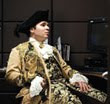Well, I have just returned from a marathon 11 hour walking tour of Berlin. It was led by this British ex-diplomat who grew up in London during the blitz and then worked in Berlin when the wall came down, so you can imagine he had some very interesting things to say, the first of which was 'German is not a language, it is noise.' We started our tour at the Neue Synagogue, which is the largest synagogue in Europe, and is a museum now. It has been completey restored by the government in the last few years, and is quite beautiful. It is a museum now, as Berlin only has 14000 Jews, down from 162,000 before the war. The building was not burned down during kristalnacht (night of broken glass) because the chief of police in Berlin was not a Nazi and he told the rioters to disperse, which they did. Unfortunately it was bombed in the last few days of the war. It was quite eery to be walking down the same streets where Jews used to live, and where so much atrocity has happened. All through the old Jewish sections, there are hundreds of cobblestones with bronze plaques, each one listing the names and dates of people who perished in the concentration camps. Sometimes there are 10 in a single block. These markers are a constant reminder of what happened. It was quite shocking to see the amount of security around all remaining Jewish buildings, even those that have not been used since the war (such as the Jewish hospital and school). There are security cameras everywhere, metal barriers, and each building is guarded by a police guard with a machine gun. Even the cafe where I had tea had this kind of security. Berlin really is a city that is still coming to terms with the war and division of the city. There are commemoritve plaques and markers everywhere telling exactly what happenned, when and where. 70 to 80 percent of central Berlin was destroyed, and that which remains is still often badly damaged, especially in the East, where they did not have the money or the desire to rebuild... After the war, the allies estimated it would take 100 years to clear out all the rubble. It took 5, and the work was done by women, all by hand. The rebuilding that has taken place in the last 10 years is extraordinary. They have literally rebuilt the city from nothing, especially the centre of the city where the wall stood. For a city to build even a few of the buildings Berlin has in a decade would be remarkable. Berlin has built embassies, hotels, train stations, museums (there are 179 in the city), housing, etc. Most of the times these are prestegious projects, designed by world famous architects. The bathrooms at the historical museum (designed by IM Pei) are floor to ceiling marble. It is no wonder the city is broke. Often, they cover partially ruined buildings with fabric painted with what the building will look like once completed, and leave it like that until the money comes through.
One of the weirdest things today was standing on the Hitler bunker. There were 2. Once has been demolished, but one still exists, although it is flooded. You can still see the trap doors leading to it, which are located right in the middle of a housing development, right by a swing set.
I also went to the holocaust memorial, which is 3000 slabs of granite in all different shapes and sizes. They are supposed to represent a delapidated Jewish cemetary, and if you walk through it, you will probably get lost, which is the point.
Berlin and Germany are struggling right now. The city and the country are broke, and there is 17 percent unemployment in the city, and up to 30 percent unemployment in the Eastern part of the country. It was also interesting to know that only 35 percent of Berliners voted for Hitler, and that there were over 40 planned attempts on his life. Also, during the Weimar republic, Germany had the most liberal constitution in the world. Well... I am off to bed. More tomorrow.
Tuesday, March 07, 2006
Subscribe to:
Post Comments (Atom)

No comments:
Post a Comment